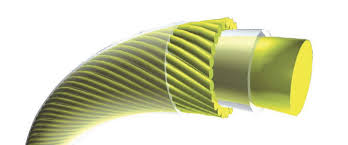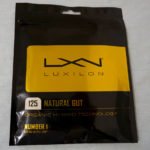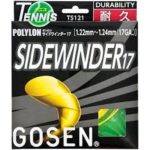The Complete Package for the Recreational Player – Part 3 – String Basics
Let’s talk about strings…..
In part 1 of this series, I talked about finding a qualified racquet technician to work with, and in part two, I gave a brief overview of what to look for when selecting a racquet. Part 3 in this series deals with a basic understanding of strings and suggestions for what might be the best selection for you and your game. First, let’s talk about the basic materials strings are made of, because this will give you some insight as to what you might like to try and why. It’s important to understand that the majority of ALL strings will fall under one of these 5 categories.
Five string materials
- Nylon
- Natural gut
- Kevlar
- Polyester
- PEEK
NYLON
This is basically what everyone refers to as synthetic gut. There are so many variations of this stuff out there today that a player can get confused just reading the list. Keep in mind, however, that in the last 15-20 years, there’s been a vast improvement in nylon string. If you’re a player who tends to follow the pack and you’re using synthetic string, then you’re in good company. The majority of players out there today are using synthetics.
NATURAL GUT
This is the standard by which all others have been measured for many years. Made from beef intestines (no, not cat gut), this stuff is the real deal. When strings stretch at impact, they absorb energy, and when they rebound, they return that energy to the ball. Nothing matches the elastic properties of natural gut, and by elastic properties, I’m referring to its ability to stretch and then return to its original state. In other words, natural gut will, by nature’s design, maintain its tension for a very long time, and that’s what makes it such a great product. Think of it this way. If you spend the money on natural gut, you can keep it in the racquet much longer than your usual synthetic because it will play better, much longer than a basic nylon string. Eventually, the gut will lose its playability and you’ll have to restring your racquet, but during this process, you’ll soon see that your set of gut performed much better for a longer period of time. If you’ve never tried natural gut, I would highly recommend that you treat yourself to a set.
POLYESTER
Also referred to as monofilament, this is a very durable string that we’re seeing more and more of today. However, keep in mind that monofilament strings are not for everyone. Here at IART, we do not recommend these strings for junior players due to their extreme stiffness (listen to audio post HERE by IART member John Gugel). As with all strings, there is a proper use for each, and with monofilaments, they are most desirable at the professional level. Go HERE for a list of qualified IART technicians and locate one in your area.
KEVLAR
This is by far the most durable string out there, but it’s also very stiff with very little elasticity, so if comfort is your goal, you should look elsewhere. I would personally recommend this string be used in a hybrid configuration. It’s suggested that you should reduce the tension by approximately 10% with Kevlar, but this stems from manufacturers’ recommendations of long ago. Once again, this is where you should seek professional advice, so go HERE for a list of qualified IART technicians if you want to try Kevlar and have a serious talk.
PEEK
Ashaway has introduced a new version of Zyex® called MonoGut, *(PEEK) that is becoming a serious competitor to standard polyester strings. MonoGut is not polyester, and the biggest difference between the two is that one stretches very little (poly) and the other (MonoGut) stretches a LOT! With Ashaway MonoGut, the player enjoys the benefit of a very soft string that has some of the playing characteristics of monofilaments, mainly the “snap back” phenomenon that makes poly so popular with the pros.
PLAYABILITY VS. DURABILITY
For the record, whoever invents a synthetic string that plays like natural gut and is as durable as Kevlar is our hero! Until that day comes, you’re stuck with two solid choices and several “in-betweens”. The two consistent ones are playability and durability. These two constants in the string will be determined by the strings composition and its gauge.
Playability & comfort
Everybody wants it, and if you want it bad enough, you’re going to pay a premium price to get it. This means you’ll be buying natural gut or a PEEK string. Here are some possible choices, and you can expect to pay over $30 for each of these strings and much more when you choose natural gut:
- Babolat Natural Gut
- Luxilon natural gut
- Bow Brand Natural Gut
- Ashaway MonoGut Pro ZX
- Gosen Remplir
- Wilson NXT
- Yonex Pro Tour Super 850
- Alpha Gut 2000
- Head FXP Power
- Gamma Solace
Durability
It’s no secret what’s going to happen for those of you who want more string life. If you want a more durable string, you’re going to make sacrifices, primarily in playability and feel. You have several options, ranging from a multitude of hybrid configurations with poly or switching to a thicker gauge string of the model you’re currently using. Remember, however, when using a hybrid with stiffer mains with poly, or thicker gauge nylons, that these strings are not as elastic as thinner nylons or natural gut, and you’re sure to notice it. Of the strings listed below, two are notable for their ability to stretch more than standard poly strings. Gosen Sidewinder is softer and more elastic and is a very good choice for juniors. Sidewinder also has two raised outer fibers that give the string additional texture for grabbing and biting into the ball. Here are a few choices in the durable category to consider:
- Luxilon 4G
- Luxilon Big Banger ALU
- Luxilon ALU Power Rough
- Prince Pro Blend
- Gosen Sidewinder
- Gosen Polylon
- Babolat Pro Hurricane Tour
- Ashaway Crossfire
- Ytex Pro Tour
- Head Hawk Touch
- Wilson Power 1.40
As you can see, the choices are endless, and in fact, we currently have over 400 different strings listed in our strings characteristic database that IART members can refer to when making a string recommendation to their customers. As mentioned more than once in this series of articles, find yourself a qualified racquet technician to help you navigate through the maze, and you’ll be just fine!
See part 1 of this series HERE
See part 2 of this series HERE
See part 4 of this series HERE






Comment (1)
Nicely done, Tim, as always.